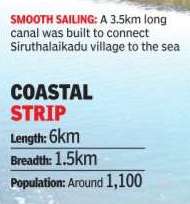Siruthalaikadu
This is a collection of articles archived for the excellence of their content. |
Siruthalaikadu
Dec 26 2014
Karthikeyan Hemalatha
How Siruthalaikadu village, which has around 300 families, turned a tragedy into an opportunity for life
On the map of India, Sirutha laikadu appears about to fall off Nagapattinam, into the Bay of Bengal. It isn't too different in real. The village of 300 families is at the tip of the `nose' on the eastern coast ravaged by the tsunami on December 26, 2004. A swamp separates the last of dwellings in the east from the shoreline by more than 3km. The swamp makes it difficult for fishermen to walk up to the sea; and it's harder on their way back with the catch.
But when tsunami struck, it was the swamp that protected Siruthalaikadu.As nobody died here, the village didn't get any tsunami aid. When other villages got pampered by government and NGOs, Siruthalaikadu villagers pressured the government to dig a canal to connect the habitable parts with the sea shore. In 2009 the canal was built in 15 days at a cost of `10 lakh. It quickly became the lifeline of Siruthalaikadu.From selling fish for petty change, 90 or so fishermen now sell catch worth at least `30,000 every day .
“Earlier we wouldn't catch more than 20kg of fish a day,“ says A Vairakannan as he opens the net to check the day's catch. “Because it was impossible to carry more through the swamp back to the village. It was a one-hour walk, you see.”
Even getting from the M landside to Siruthalaikadu is difficult. The villagers joke that the only visitors are those who lose their way. About 60km from Nagapattinam town, the road after Vedaranyam narrows between scrub forests. About 10km later, the road abruptly ends in the vast stretch of marsh.
Soon after the tsunami, the villagers didn't know whether to feel happy or sad. Neither the giant waves reached them, nor did aid from the government or NGOs. “We saw neighbouring villages develop with all the tsunami money. And we were still struggling with the only occupation we know,“ said K Karupayy an, vice-president of Pancha nadikulam panchayat that Siruthalaikadu is part of.
They sent petition after petition to the col lector to build a canal to connect their village to the sea. Two years later, it happened in a jiffy. H e av y e a r t h m o ve r s worked for a fortnight, and Siruthalaikadu had a gleam ing stream that extended from its fringes to the sea. “Before the canal, we could sell only within our villages or eat the fish ourselves. Now we have auctions everyday, selling fish for up to `30,000,“ said Karupayyan. “People from inland villages like Marudar, Adanur and Thalanayar come and buy fish from us.“
The tsunami did damage some of their 55 small `paimara' boats. Now there are 90 fishermen, all with fibre boats that bring in more catch. “The building of the canal was one of the most innovative interventions. It reflects the growing aspirations of the villagers,“ said Jeyakumar, project associate with M S Swaminathan Research Foundation that has been desilting the canal.
